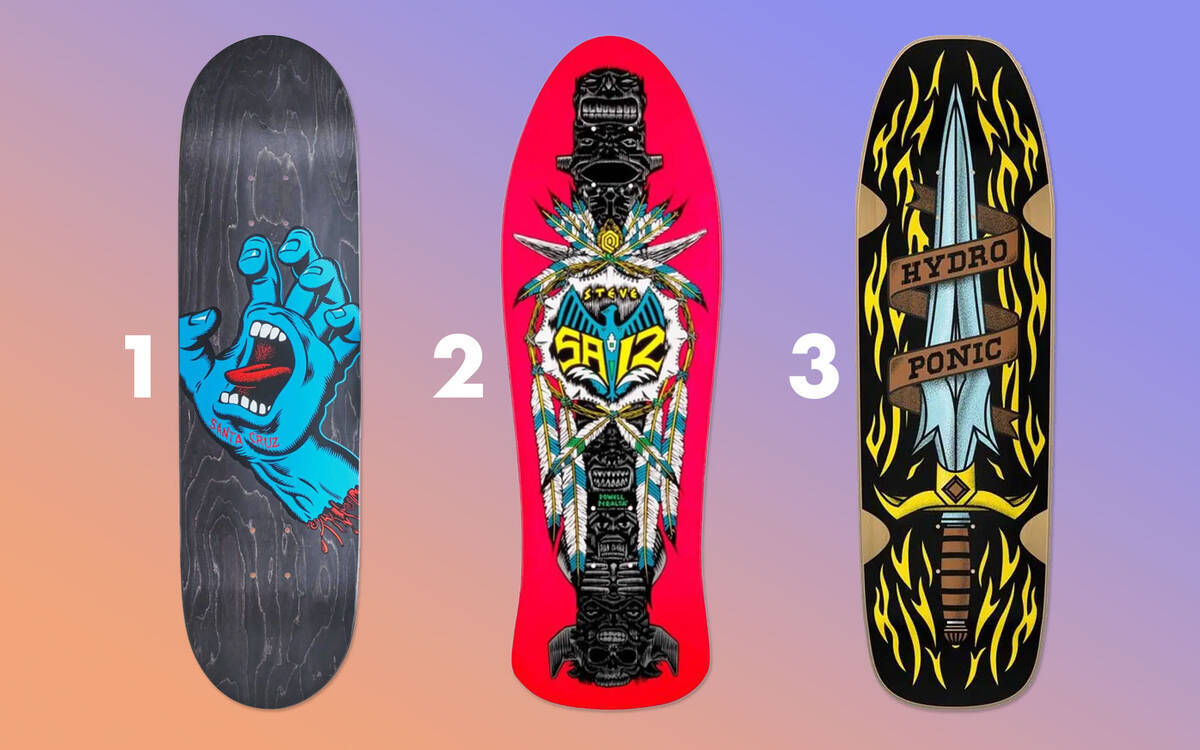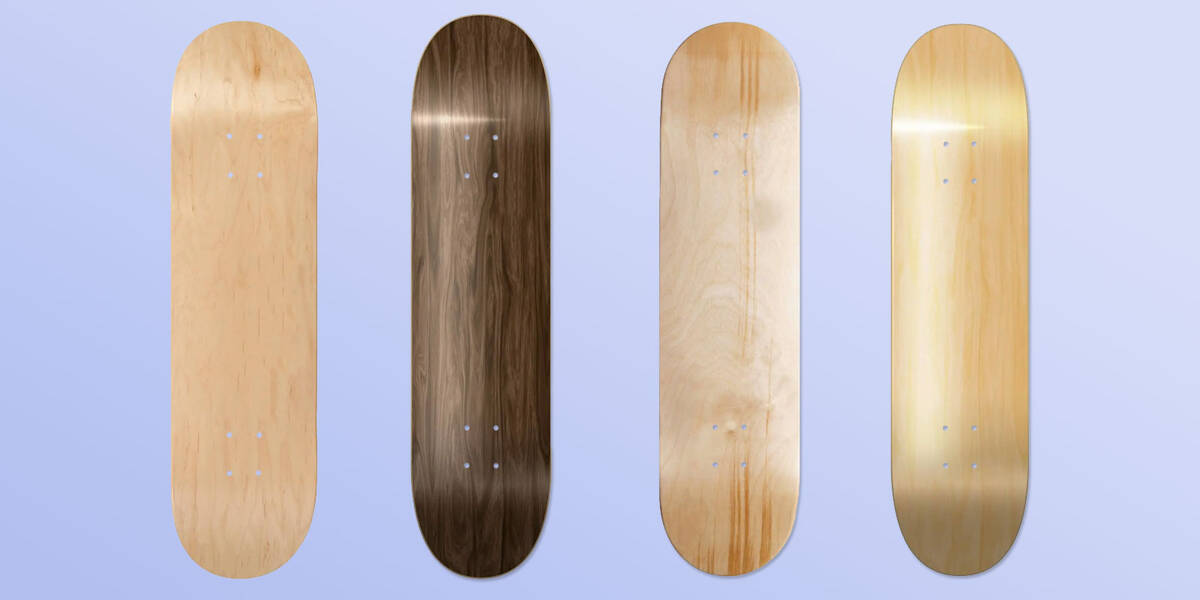Guide to Purchasing Skateboard Decks
Opting for the correct skateboard deck is not an intricate task, but it does require thoughtful consideration beyond selecting the most attractive deck graphics. You might find yourself questioning how to determine the appropriate skateboard deck size, or which skateboard deck shape will best suit your needs. What is the optimal wood type for constructing a skateboard deck?
Whether you're seeking recommendations for beginners or are an experienced skater in search of a new deck, this buying guide is designed to address any queries that might arise during your quest to secure the ideal skateboard deck.
Overview
Skateboard Deck Dimensions: Selecting the Appropriate Size
Your shoe size provides useful guidance in identifying the most fitting skateboard deck width for you. As your shoe size increases, so should the width of your deck.
Your skateboarding style also plays a crucial role in determining the width of the deck. Vert and bowl skating generally benefit from a wider deck, whereas street and flip tricks are often easier with a narrower one. Consider these points:
- Wider decks: Offer enhanced stability and make landing tricks easier due to a bigger landing surface for your feet. However, the added width results in more weight, necessitating additional power both to elevate the skateboard and to flip it in the air.
- Narrower decks: Provide greater agility and are easier to flip due to their lighter weight. Nonetheless, the reduced size may make it more challenging to catch the board during a flip, potentially making trick landings a bit more complex.
The ultimate decision boils down to your personal taste, but we advise consulting our skateboard size guide to get an understanding of the optimal skateboard deck size relative to your shoe size.
ALIGNING DECK WIDTH AND TRUCK WIDTH

In aligning your skateboard deck with the trucks, the standard recommendation is as follows: Ensure that the width of your skateboard deck corresponds with the axle width of your skateboard trucks. Ideally, the axle width should match the width of your deck, with any deviation not exceeding a quarter of an inch.
Ultimately, it's your setup, and personal preferences may vary, but this guideline is one most skaters would do well to follow.
SKATEBOARD LENGTH CONSIDERATIONS
The length of a skateboard deck may not be a significant issue for every skater, given that deck length typically aligns proportionally with width—wider decks tend to be longer, while narrower ones are shorter. Generally, skateboard deck lengths range from 29” to 32”.
Deck length is vital because it dictates the wheelbase, influencing how steady your assembly feels. Additionally, leg length is a factor: those with shorter legs might find a shorter deck easier to manoeuvre, while individuals with longer legs may have better control with a longer deck.
If you are interested in particularly long skateboards, feel free to explore the following pages:
Skateboard Deck Configurations: Popsicles, Eggs & Hybrids

1. Popsicle form 2. Old School Form 3. Hybrid Form
These days, skateboard decks are primarily linked with the popsicle shape, a mere step in a continuing evolutionary journey. The emergence of new skateboard deck styles aligns closely with skateboarders' creative pursuits, pushing the boundaries of their abilities.
POPSICLE SKATEBOARD DECKS
Popsicle skateboard decks feature a kick-tail and a kick-nose, enabling skaters to execute tricks from either end. The nearly symmetrical design ushered in a variety of possibilities for fakie tricks, nollies, nose slides, riding switch, etc. Popsicle decks are closely tied to the ascendance of street skateboarding in the early '90s, with skaters pioneering flip tricks, slides, and grinds in urban environments.
DESIGNED SKATEBOARD DECKS
Like any trend, the popsicle stick shape is merely one of numerous skateboard deck types. So-called hybrid decks blend the popsicle form with the contours of vintage decks.
Some skateboarders prefer egg-shaped decks, usually more than 9 inches wide. Instead of parallel edges like a popsicle stick, they exhibit an oval design, offering some of the popsicle shape's agility while providing a spacious, stable footing platform.
Various old-school decks are available on the market. Whether you take them to the bowl or explore the streets is your choice entirely! Check our cruiser decks for some charmingly retro designs:
How Does Deck Concave Benefit Your Skateboarding?

Deck concave serves as a significant aspect of modern decks that accompanied the progression of technical street skateboarding. Concave refers to the curvature from one edge to the other. Many skaters perceive that concave facilitates easier flicking during flip tricks, provides more leverage for tricks, maintains foot positioning during action, and also adds stiffness to the deck. Typically, skateboard deck concave comes in three types: low, medium, and high:
- Low concave: Slight curvature offering a stable ride with a reduced centre of gravity.
- Medium concave: Assists in executing flip tricks and enhances control. Seen as a reliable choice.
- High concave: Pronounced curvature greatly alters board characteristics, enhancing agility and facilitating flips.
Consider how the deck concave you choose influences your skating experience, affecting these factors:
- Deck comfort and feel
- Trick leverage capabilities
- Deck stiffness, thus impacting its pop
Which Woods Are Utilised in Skateboard Deck Construction?

Maple stands as the predominant choice for skateboard deck construction, attributed to its inherent properties like strength, resistance to impact, light weight, and flexibility.
Skateboard decks are assembled from multiple wood layers, pressed together with either glue or epoxy between each layer. The majority are composed of 7-ply maple, meaning 7 layers of maple. Maple's adaptability to shaping and its ability to maintain shape make it a preferred material for skateboards.
Maple variants differ in characteristics. For instance, Canadian maple is acknowledged as 15% tougher than its Chinese counterpart, thanks to the tree's slower growth in chillier climates, resulting in denser growth rings compared to maple from milder regions.
If your aim is a deck capable of enduring extensive use with ample pop and rigidity, go for the hardest wood available. Beginners, however, might not feel the differences in hardness are as significant as price variations, allowing them to learn and experiment on a less premium deck without issue.
Conclusive Skateboard Deck Advice and Resources
When purchasing a new deck, ensure you have some griptape on hand. Browse our extensive selection:
Discover additional general information about skateboard components in this guide:
For clarification on griptaping your deck or any skateboard assembly topic, explore this guide:
Explore our complete offerings here:
If assembling a complete skateboard from your preferred components interests you, we provide a very convenient option for you
